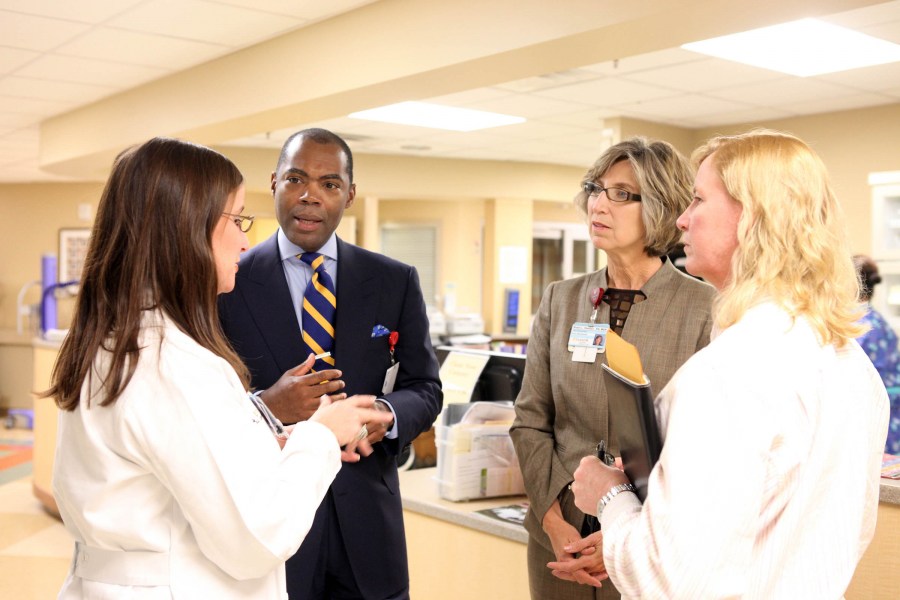
Taking part in a recent safety rounding session at the Vanderbilt Heart and Vascular Institute were, from left, Erin Martin, MSN, R.N., Keith Churchwell, M.D., Robin Steaban, R.N., and Janet Franks, BSN. (photo by Susan Urmy)
Heart Institute embraces new safety rounding program
Hospital staff at Vanderbilt Heart & Vascular Institute are getting used to being approached at random by VHVI leaders and asked about patient safety.
The questions can be quite direct:
“When is the next time we’ll harm a patient?”
“What is the biggest threat to reliable patient care?”
“Tell me about something you do and, when you do it, you know you shouldn’t be doing it.”
It’s called safety rounding, and it’s part of an effort to advance an organizational culture of safety and high reliability.
In intensive care units at Vanderbilt University Hospital, Lee Parmley, M.D., J.D., director of the Division of Critical Care, does safety rounds. Perioperative Services leaders at the Monroe Carell Jr. Children's Hospital at Vanderbilt plan to pilot monthly safety rounds soon.
Vanderbilt leaders look forward to other areas of the Medical Center also adopting the practice.
“Habitual safety rounding will become part of Vanderbilt’s journey toward advancing a culture of safety and high reliability,” said Julie Morath R.N., M.S., chief quality and safety officer.
According to Morath, safety rounds serve a twofold purpose: leaders experience the full complexity of the delivery system and learn first-hand the safety concerns of frontline care providers and staff; and leaders demonstrate their commitment to making health care safer.
“Safety is extremely important and rounding is part of our effort to advance a culture of safety,” said Keith Churchwell, M.D., executive director of VHVI, who as often as once a week goes to any of five patient care units at VHVI to engage staff in one-on-one safety discussions.
They take a broad view of safety at VHVI. Rude speech presents a safety risk because it hampers clinical communication; an awkward physical layout can present risk; all sorts of staff workarounds may present risks by thwarting basic safety precautions.
“When we first started safety rounding, people thought they had to be on their best behavior, that they had to hide the dirt,” said Robin Steaban, R.N., VUMC associate chief nursing officer and chief administrative officer at VHVI. “Staff should feel free to tell us everything. We want to know. It’s OK to say you made an error, or someone else made an error. We get it.”
Steaban offers these tips to leaders who may be planning to begin safety rounds: as you begin posing safety questions to staff, first be sure that you want to hear the answers; have a response plan; and be prepared to reward people for revealing discomforting information.
Once every week or two, as he’s walking between appointments, Chief of Cardiovascular Medicine Doug Sawyer, M.D., stops to engage a VHVI staff member about safety. He admits to still being somewhat uncomfortable on these occasions, because he never knows what to expect, and, “It’s not what I was trained to do.
“I don’t think I do anything other than make people aware that I think safety is important,” he said, adding that rounding also helps make him more knowledgeable. “I can sit in meetings with nurses and have better conversations.”
One of the first issues uncovered in safety rounds at VHVI was staff frustration over the frequent fallibility of contact information for each patient’s responsible provider.
Steaban said one of their goals at VHVI is to have unit managers and assistant managers conduct safety rounds of their own. In a related initiative, they’ve launched unit-based safety teams.
Churchill, Sawyer and Steaban occasionally round together. On one such occasion a couple of months ago, leaders from Children’s Hospital tagged along to gather pointers.
“Rounding will help with staff engagement,” said Gina Whitney, M.D., assistant professor of Anesthesia and Pediatrics. “Our best resources for safety improvement are experienced frontline providers who aren’t afraid to speak up and know that their feedback is valued.”
For more information on safety rounding, contact Julie Morath or Michael Cull at Quality and Patient Safety at 322-2560.













